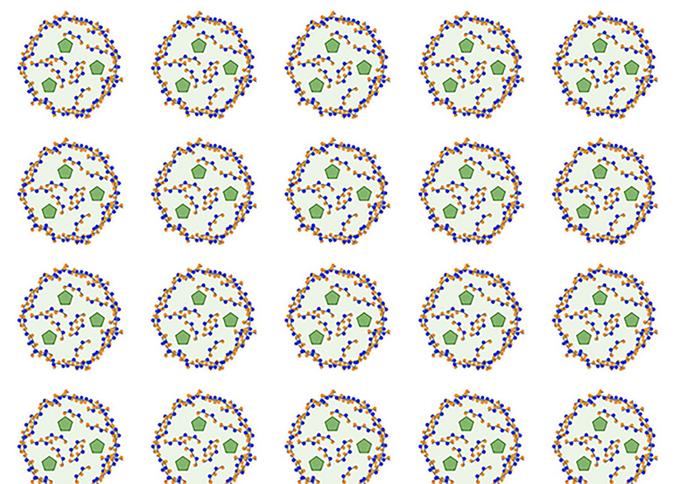Researchers headed by teams at the Advanced Science Research Center at the CUNY Graduate Center (CUNY ASRC) and Memorial Sloan Kettering Cancer Center have developed what they describe as a groundbreaking approach to using specially designed peptides as excipients to improve nanoparticle drug formulations. Preclinical tests showed that their method could significantly enhance the antitumor efficacy of a peptide-drug formulation containing the JAK2/FLT3 inhibitor lestaurtinib in acute myeloid leukemia models.
“This breakthrough enables the development of better precision medicines,” said co-principal investigator Daniel Heller, PhD, head of the Cancer Nanomedicine Laboratory at Memorial Sloan Kettering Cancer Center’s Molecular Pharmacology Program. “Using specially designed peptides, we can build nanomedicines that make existing drugs more effective and less toxic and even enable the development of drugs that might not be able to work without these nanoparticles.”
Heller and colleagues reported their studies in Chem, in a paper titled, “Directed discovery of high-loading nanoaggregates enabled by drug-matched oligo-peptide excipients,” in which they commented, “This work found that oligopeptides can be designed to efficiently co-assemble with therapeutic cargoes to result in high-loading nanoparticles that improve antitumor efficacy.”
Drug delivery systems often face two critical challenges: poor solubility and inefficient delivery within the body. Many drugs do not dissolve well, making it difficult for them to reach their intended targets. And while nanoparticles (NPs) can improve drug pharmacokinetics, low loading efficiencies can limit treatment efficacy, the investigators noted. “… many drug-delivery systems do not exhibit high loading efficiency; often they are in the range of 5–10% drug by mass, which limits their potential efficacy.”
One potential strategy is to co-assemble drugs with stabilizing excipients to create drug-loaded nanocarriers, “… where the drug functions as a structural component of the NP, is a potential alternative that can significantly increase loading efficiency, up to 90%,” they continued.
For their reported study the research team developed a novel solution by designing peptides that bind with specific drugs to create therapeutic nanoparticles. “We investigated peptides as designer excipients because of their diverse chemical space and inherent biodegradability,” the scientists noted. They used a combination of computer models and laboratory tests to identify new drug/peptide nanoparticle candidates. “We designed pentapeptide scaffolds to mimic the structure of known indocyanine excipients by modulating aromaticity, rigidity, and charge,” the team further explained.
The nanoparticles are primarily composed of the drug, with a thin peptide coating that improves solubility, enhances stability in the body, and optimizes delivery to targeted areas. Remarkably, the team found that their approach allowed them to achieve drug loadings that were a dramatic improvement over those possible using traditional methods. “By screening 23 drug candidates and 8 peptide designs for the capability to form particles and aid the dispersion in aqueous media, we identified peptide scaffolds that produced drug-peptide particles with up to 98% drug loading,” they stated.
The investigators subsequently demonstrated positive results in leukemia models, finding that the nanoparticles were more effective at shrinking tumors when compared with the drugs alone. Additionally, the high efficiency of the nanoparticles allows for lower doses of drugs, potentially reducing the side effects. “Using acute leukemia models, we found that the oligopeptide drug NPs increased the treatment efficacy of the inhibitor substantially in vitro and in vivo,” they stated.
“Peptides, which are designed molecules made from the same building blocks as the proteins in our body, are extremely versatile,” said co-principal investigator Rein Ulijn, PhD, director of the Nanoscience Initiative at CUNY ASRC and a chemistry professor at Hunter College. “We thought they could be useful in solving two big problems seen in many drugs: poor solubility and inefficient delivery. By designing a peptide that binds the drug while enhancing its solubility, we were able to create nanoparticles with very high loading.”
Naxhije “Gia” Berisha, a former CUNY Graduate Center PhD student who performed much of the experimental work, highlighted the potential of the peptide approach: “We used experimental testing to identify promising peptides and computational modeling to analyze their interactions with therapeutic molecules,” she said. “It’s incredible to see how simple variations in peptide sequence could match specific drugs. This suggests there may be a peptide match for every drug, potentially revolutionizing the way medicines are delivered.”
The researchers suggest that their work holds significant potential because peptides can be customized to enhance the effectiveness of various drugs. Given the vast range of possible interactions in peptide design, it may be feasible to tailor peptides for specific drugs, extending their applicability beyond cancer treatments.
The research team is now adopting lab automation methods to further refine and accelerate the peptide-drug matching process. Their next steps include verifying the approach’s potential in a wider range of diseases. If successful, this innovation could lead to more effective treatments, reduced side effects, and significant cost savings in drug development.
The authors wrote, “In the short term, the research aims to inspire the exploration of peptides as modular drug excipients with respect to the sequence specificity of their drug-carrying ability and their potential to improve drug pharmacokinetics. In the long term, the goal of this work is to develop peptide-based nanocarriers that enable the improvement of drug efficacy in the clinic.”



